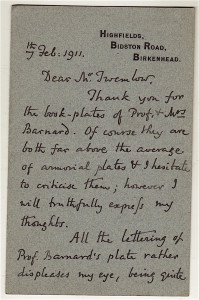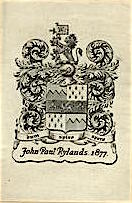 Bookplates have been out of fashion for many decades, but throughout most the nineteenth century up to the early twentieth century, bibliophiles spent good money commissioning artists to design these very personal items. The bookplate craze reached a sort of height in the Edwardian period and the following unpublished two letters from the lawyer, antiquarian and businessman, (1846 – 23) dates from this era. The addressee is J.A. Twemlow (1867 – 1954), a medieval historian and archivist who became an authority on the early history of Liverpool.
Bookplates have been out of fashion for many decades, but throughout most the nineteenth century up to the early twentieth century, bibliophiles spent good money commissioning artists to design these very personal items. The bookplate craze reached a sort of height in the Edwardian period and the following unpublished two letters from the lawyer, antiquarian and businessman, (1846 – 23) dates from this era. The addressee is J.A. Twemlow (1867 – 1954), a medieval historian and archivist who became an authority on the early history of Liverpool.
Highfields,
Bidston Road,
Birkenhead,
7th Feb: 1911
Dear Mr Twemlow,
Thank you for the book-plates of Prof & Mrs Barnard. Of course they are far above the average of armorial plates & I hesitate to criticise them; however I will truthfully express my thoughts.
All the lettering of Prof. Barnard’s plate rather displeases my eye, being quite modern. I should have liked more mantlet; but that is merely a matter of taste, for the present mantlet follows some excellent examples.
In Mrs Barnard’s plate the strong contrast of black & white does not commend itself to me as it produces a rather patchy effect ; and in the dexter shield I think the bear might have been bigger with advantage . The arms on kirtle & mantle are near for a modern bookplate & very charming.
I send a few plates that will probably interest Prof Barnard . My late father’s (J.G.Rylands ) is by the late Fr Anselm, so is mine on toned paper, but the block was plugged & the arms & crest re-cut by Oliver Silk of Liverpool, who drew & cut my plate (1896) on grey paper,& the smaller one (1890) is from the larger block, reduced—the lettering is mine . My brother’s (W.H.R.) plate is one done by Menestrier, with the arms & crest re-drawn by Fr Anselm. Any plate with the Elizabethan cartouche was reproduced by photo. Process from a drawing made by my brother (1899) who took the mantlet from an old marble monument.
Yours very truly,
J.Paul Rylands
14th Feb. 1911
Highfields,
Bidston Road,
Birkenhead
Dear Mr Twemlow,
You are very welcome to another copy of the gift- plate & I enclose it, with the plates that you returned.
 My brother’s plate ( which looks like the work of Moring or Harry Soane ) was designed & supplied in 1873 by Paul Menestrier & Co, 331, Strand, London & was altered in 1877, by Fr Anselm. P. Menestrier published under the editorship of Capt: J. Bertrand Payne (who also edited Haydn’s Index of Biography, 1870) a magazine entitled “Ye King of Arms “which began in Oct: 1873 & came to a sudden stop at page 240, in Jan:1874. It was through this magazine that my brother’s plate was obtained. Probably this firm‘s name was a fanciful one suggested by the French heraldic family of the Menestriers . What became of the firm I do not know.
My brother’s plate ( which looks like the work of Moring or Harry Soane ) was designed & supplied in 1873 by Paul Menestrier & Co, 331, Strand, London & was altered in 1877, by Fr Anselm. P. Menestrier published under the editorship of Capt: J. Bertrand Payne (who also edited Haydn’s Index of Biography, 1870) a magazine entitled “Ye King of Arms “which began in Oct: 1873 & came to a sudden stop at page 240, in Jan:1874. It was through this magazine that my brother’s plate was obtained. Probably this firm‘s name was a fanciful one suggested by the French heraldic family of the Menestriers . What became of the firm I do not know.
Sincerely yours,
J.Paul Rylands.
I return Prof Barbard’s interesting letter.
Father Anselm, a monk of St Bernard’s Cistercian Abbey, Leicestershire, was a renowned heraldic artist whose best work has been compared with the greatest art of the fifteenth century. Oliver Silk (1857 – 1930) was a landscape painter who may have had connections with the Wirral. Harry Soane was an artist who seems to have specialised in bookplates. [R.M.H]

I have been trying to find the time to visit Rylands for a numebr of years to take a look at this archive. Now that Matthew has comprehensively catalogued the collection it will make my visit very rewarding.I am related to George R Sims though my maternal grandmother who was his 1st cousin. The story as to how the collection reached Ryland is itself very interesting. There was renewed interest in George R Sims in late 1960s as a result of Arthur Calder Marshall’s book containing a numebr of ballads Prepare to Shed Them Now’ .In more recent years Social Historians have frequently made reference to the importance of his writings on Poverty, homelessness etc. A very good example is Stephen Inwood’s book: City of Cities: The Birth of Modern London published in 2005.